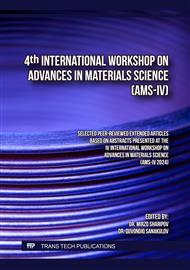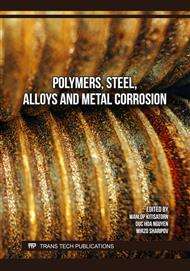[1]
William D. Callister, David G. Rethwisch, Fundamentals of materials science and engineering: an integrated approach, 3rd ed. United States, 2007.
Google Scholar
[2]
Myer Kutz, Mechanical engineers handbook: materials and engineering mechanics, Fourth edition, United States, 2015.
Google Scholar
[3]
Y. Chamdali, K. Tunç, Thermodynamic Analysis of Electric Arc Furnace Steel Production, International Journal of Engineering Research and Development (2024)
DOI: 10.29137/umagd.1418120
Google Scholar
[4]
M. Tunc, U. Camdali, G. Arasil, Energy Analysis of the Operation of an Electric-Arc Furnace at a Steel Company in Turkey, Metallurgist, 59(5-6) (2015)
DOI: 10.1007/s11015-015-0130-5
Google Scholar
[5]
U. Camdali, M. Tunc, G. Arasil, Analysis of an Electric Arc Furnace Used for Casting of Steel: An Exergy Approach, Metallurgist, 64(5-6) (2020)
DOI: 10.1007/s11015-020-01018-4
Google Scholar
[6]
B. Tian, G. Wei, X. Li, R. Zhu, H. Bai, W. Tian, K. Dong, Effect of hot metal charging on economic and environmental indices of electric arc furnace steelmaking in China, Journal of Cleaner Production, 379 (2022)
DOI: 10.1016/j.jclepro.2022.134597
Google Scholar
[7]
Y. Liu, G. Wei, B. Tian, Analysis and optimisation on the energy consumption of electric arc furnace steelmaking, Ironmaking and Steelmaking, 50(8) (2023)
DOI: 10.1080/03019233.2023.2172826
Google Scholar
[8]
L. Yang, H. Hu, M. Wang, F. Chen, S. Wang, Y. Guo, S. Yang, T. Jiang, Comparative life cycle assessment and techno-economic analysis of electric arc furnace steelmaking processes integrated with solar energy system, Journal of Cleaner Production, 425 (2023)
DOI: 10.1016/j.jclepro.2023.138868
Google Scholar
[9]
H. Hu, L. Yang, G. Wei, Y. Zou, B. Xue, F. Chen, S. Wang, Y. Guo, Numerical Simulation of Scrap Preheating with Flue Gas in EAF Steelmaking Process, Minerals, Metals and Materials Series (2024)
DOI: 10.1007/978-3-031-50304-7_55
Google Scholar
[10]
L. Yang, Z. Feng, Y. Zhao, Y. Peng, H. Hu, Y. Zou, S. Wang, F. Chen, Y. Guo, Reaction Mechanism in EAF Steelmaking Process Based on Selective Oxidation, Bath Stirring and Furnace Body Heat Transfer, Minerals, Metals and Materials Series (2024)
DOI: 10.1007/978-3-031-50304-7_64
Google Scholar
[11]
Z. Ermatov, N. Dunyashin, B. Yusupov, A. Saidakhmatov, M. Abdurakhmonov, Modelling the chemical composition process concerning formation of metals from manual arc surface on the basis of the electrode coating charge components classification, International Journal of Mechatronics and Applied Mechanics, 12 (2022)
DOI: 10.17683/ijomam/issue12.25
Google Scholar
[12]
S. Turakhujaeva, K. Karimov, N. Turakhodjaev, A. Akhmedov, Mathematical modeling of quantitative changes in hydrogen and oxide inclusions in aluminum alloy, E3S Web of Conferences, 365 05016 (2023)
DOI: 10.1051/e3sconf/202336505016
Google Scholar
[13]
U. Mardonov, O. Khasanov, A. Ismatov, A. Baydullayev, Studies Concerning Water-Based Coolants Under Magnetic Field During a Metal-Cutting Process (Turning), Lecture Notes in Networks and Systems, 762 LNNS (2023)
DOI: 10.1007/978-3-031-40628-7_26
Google Scholar
[14]
N. Kholmirzaev, N. Turakhodjaev, N. Saidmakhamadov, J. Khasanov, S. Saidkhodjaeva, N. Sadikova, Development of Technology of Making Shafts from Steel Alloy 35XGCL, Lecture Notes in Networks and Systems, 762 LNNS (2023)
DOI: 10.1007/978-3-031-40628-7_18
Google Scholar
[15]
N. Turakhodjaev, M. Akramov, S. Turakhujaeva, S. Tursunbaev, A. Turakhujaeva, J. Kamalov, Calculation of the heat exchange process for geometric parameters, International Journal of Mechatronics and Applied Mechanics, 1(9) (2021) 90-95
DOI: 10.17683/IJOMAM/ISSUE9.13
Google Scholar
[16]
P. Beeley, Foundry Technology Second Edition, Butterworth Heinemann, 2001.
Google Scholar
[17]
A. Bührig‐Polaczek, H. Träger, Foundry Technology, In Ullmann's Encyclopedia of Industrial Chemistry (2012)
DOI: 10.1002/14356007.a12_035.pub2
Google Scholar



